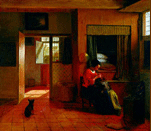










39.
Truth in the Telling: Gendering Structures
of Authenticity in Early Modern and Academic Contexts
Organizers:
Description:
Truth, perhaps the preeminent epistemological category in the early modern
thinking, gets surprisingly little airtime these days, especially if and when
we consider it as generic byproduct, an effect of the very discourses in which
it is uttered. In the following workshop we hope to interrogate truth’s
formal structures as they are represented in the early modern women’s
texts that we teach and in the methods that we employ to authorize our own
versions of the authentic. We will follow an open-discussion format, dividing
our session into two interrelated conversations, the first focusing of the
materials that we study, the second on the critical practices that we employ
as we teach and learn the early modern world.
In the first portion of our workshop we envision two 20-minute discussions
each focusing on the authentic as it is constructed in the 17th century. In
opening we will turn to the private writing of early modern women and that
most seemingly familiar and naturalized of all English writings—the
diary. Often lauded as a prototype to modern notions of interiority and personal
revelation, the early modern diary ostensibly professes its truths in promises
of authentic self-disclosure. While scholars have been correct to question
that formulation, to recognize diurnal structure as narrative fabrication,
our critical proclivities have led us away from the concept of truth itself.
In the first segment of our workshop then we hope to retrieve and recalibrate
notions of truth as they are reflected in early modern diary writing. It is
our contention that the early modern autobiographical form created a gender-based
relationship to truth—a relationship that enabled, in the case of many
women writers, a unique and sometimes revolutionary rethinking of early modern
meaning-systems. Of the many 17th-century English women’s diaries available
to us, Lady Anne Clifford’s extensive musings, collected in triplicate
in the Clifford “Great Books,” will provide an early focus.
In the next portion of our workshop, also focused on the early modern past,
participants will turn to a second and more apparently public kind of “structured”
truth, the Peruvian exclamación—a formalized outburst in the
notarial record that literally voiced protest or refusal. Commissioned mainly
though not exclusively by women, these mediated exclamations were produced
by a small coterie of official male scribes according to standardized protocols.
It is here, facilitators would like to suggest, that the formulaic language
of contractual obligation begins to break down. One of the most textually
disruptive documents in the notarial repertoire—the exclamación
gave women access to a form of public protest against patriarchal male violence
and coercion—a semi-formal restraining order that spoke the truth of
institutional imbalance within one of its most sympathetic forums. While we
may be tempted on the one hand to discount the highly mediated exclamación
as less “truthful” than the diary in what it can tell us about
early modern women, a public artifact institutionally distanced from the women
that it purports to represent, and on the other to dismiss the diary as historically
unreliable, a private and biased account, workshop facilitators would like
to suggest instead the importance of seeing beyond those binaries, both historically
and structurally. We ask participants to consider how the very structures
of authenticity that both forms employ (confession, notarial protocol) shape
the kinds of truths that they are able to tell and the purposes to which they
can be put.
We plan to spend the last 50 minutes of our workshop, the bulk of our time,
exploring categories of truth and form as they reflect on and in our own critical
work. Obviously there will be a good deal of overlap here as it is impossible
to talk about current practice without thinking about the materials that it
engages. In this discussion questions of pedagogy will take precedence as
we begin to think through the ways that we learn and teach early modern “truths.”
We will consider as well the way that we as literary critics and historians
depend on different standards of authenticity to evaluate and frame the materials
that we study. Gender as a category of authenticity should once again come
to the fore, as a means to talk about why this work continues to matter for
us as women academics. Avenues that we may wish to pursue in this discussion
might include the following:
Thinking about truth in structural terms, as the unique production of a series of formal and gendered patterns of disclosure, underscores the very real connection between subjective authority and the shape and direction of narrative—theirs and ours. It reveals what’s paramount to our task as teachers and educators—our testimonial relationship to and with the historical “truths” we are telling.
While the seventeenth century has often been lauded as for its introspective turn a, fewer diaries have been published across the period than have memoirs, roughly one-third of the total sample. The ratios, though, are markedly lower for women. This imbalance may have something to do with survival rates. As diary-writers ostensibly identified no audience beyond the self, so too, their works would be less secure for posterity, more easily disposable. This ephemeral quality was no doubt exacerbated in women’s writings where reasons of modesty and perceptions of historical insignificance kept numbers down. We hear of second-hand accounts of women who destroyed manuscripts when they feared discovery or asked that they be burnt upon death. In his eulogy to Lady Anne Clifford, Bishop Rainbow apologized for her literary presumption. Pepys’s tells us that his wife wrote an account of their lives too accurate to be comfortable. Still, the disproportionately small number of seventeenth-century women’s diaries that survives is worth contemplating. Of the twenty-eight autobiographies written by women that we have encountered, only three could be said to privilege a diurnal form, and even here the narrative is not uniformly serial in composition. In this workshop we want to examine that imbalance, exploring the reasons why early modern women found it difficult to write diaries and why when they did write diaries their narratives took exceptional shape.
Albeit that Sainct Augustine, attributed much to histories, yet doth he adde, that hee can not see how all that which is written by the witte of man can bee in everie point true, consideringe that all men are lyers, and that it commeth to passe often tymes, that they which follow the reason of man in anye historie, builde uppon the brutes of the vulgar sorte, and are abused by the passions of sundrie men, which report nothinge of certayn.” (Matthieu Coignet, Politique Discourses upon trueth and Lying, trans. Sir Edward Hoby [London 1586], 72).
Preliminary Readings (total 10 pages):
Secondary Sources (total 10 pages):
|
|
|
||||||
|
|
 |
 |
|
||||
 |
|
 |
|
||||
|
|
|
||||||
|
|
|
||||||
 |
|
||||||
|
|
|
||||||
| |
|
||||||
 |
|
||||||
 |
|
||||||
 |
|
||||||
 |
|
||||||
|
|
|
||||||
|
|
 |
|
|
||||
 |
|
||||||
|
|
|
|
|
|
|
|
|